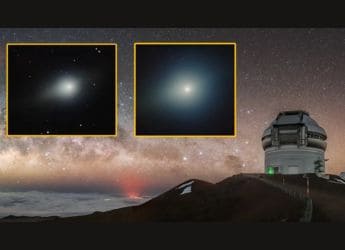- Home
- Science
- Science News
- Partial Lunar Eclipse 2019 Today: India Timing, Facts, All You Need To Know
Partial Lunar Eclipse 2019 Today: India Timing, Facts, All You Need To Know
The partial lunar eclipse will be visible in a majority of continents except for North America.

Photo Credit: NASA
Partial lunar eclipse July 2019 is the last lunar eclipse of this year.
Stargazers will witness a partial lunar eclipse on July 16 and July 17, with people in India getting to watch the celestial event on July 17. Partial lunar eclipse, as the name suggests, takes place when the shadow of Earth covers only a small part of the Moon and as a result, only a minor section of the Moon appears dark. The upcoming lunar eclipse will be the last one to happen in 2019 and it will be visible in a majority of Africa, Asia, Australia, Europe, and South America. The timing of this lunar eclipse is pretty interesting as it coincides with the 50th anniversary of the launch of Apollo 11 mission that first landed humans on the Moon. Here's everything you need to know about partial lunar eclipse 2019.
2019 partial lunar eclipse date, time
As mentioned above, the partial lunar eclipse will be visible in the majority of Asian nations, including India. The people living in the western and central region of India will witness the entire event, while those living in the eastern regions will get to see the partial lunar eclipse at moonset time in the wee hours.
The Moon will enter the penumbra on July 17 at 12:13am IST and will enter the umbra region at 1:31am IST. The intensity of the partial lunar eclipse will be highest (the time at which at the largest chunk of moon will be covered by Earth's shadow and thus, will appear dark) at 3:00am India time.
The Moon will leave the umbra region at 4:29am IST, which also marks the end of the partial lunar eclipse. The Moon will exit the penumbra region at 5:47am IST, as per NASA's data. The total eclipse duration will be 2 hours, 57 minutes and 56 seconds.
![]()
NASA's map showing regions of the globe from where the eclipse will be visible
Photo Credit: NASA
July 16 Partial Lunar Eclipse: Facts and figures
As mentioned above, the partial lunar eclipse that will be visible on July 17 (July 16 in some regions of the globe) will be the last lunar eclipse – partial or global – that will happen in 2019. The only other lunar eclipse recorded this year was witnessed in January and it was a total lunar eclipse.
As for the July 17 partial lunar eclipse, the penumbral magnitude will be 1.7037 and the umbral magnitude will be 0.653. As per the eclipse map released by NASA, the event won't be visible in North America and Greenland.
What is a partial lunar eclipse?
When the Earth comes in between the Moon and the Sun and casts its shadow over the Moon, cutting off its source of illumination and making parts of it appear dark, the event is caused a lunar eclipse. When the Moon is fully covered by Earth's shadow, it is called a full lunar eclipse, but when only a small portion of the moon appears dark due to incomplete overlapping, it is called a partial lunar eclipse.
Special Significance of lunar eclipse 2019
The partial eclipse happening tomorrow is a little special for people in India as it marks a coincidence happening after 149 years. The Guru Purnima celebrated in India will happen on the same day as the upcoming partial lunar eclipse for the first time after a span of 149 years. And if you believe in astrology, this coincidence can be of special religious significance.
Get your daily dose of tech news, reviews, and insights, in under 80 characters on Gadgets 360 Turbo. Connect with fellow tech lovers on our Forum. Follow us on X, Facebook, WhatsApp, Threads and Google News for instant updates. Catch all the action on our YouTube channel.
Related Stories
- Samsung Galaxy Unpacked 2025
- ChatGPT
- Redmi Note 14 Pro+
- iPhone 16
- Apple Vision Pro
- Oneplus 12
- OnePlus Nord CE 3 Lite 5G
- iPhone 13
- Xiaomi 14 Pro
- Oppo Find N3
- Tecno Spark Go (2023)
- Realme V30
- Best Phones Under 25000
- Samsung Galaxy S24 Series
- Cryptocurrency
- iQoo 12
- Samsung Galaxy S24 Ultra
- Giottus
- Samsung Galaxy Z Flip 5
- Apple 'Scary Fast'
- Housefull 5
- GoPro Hero 12 Black Review
- Invincible Season 2
- JioGlass
- HD Ready TV
- Laptop Under 50000
- Smartwatch Under 10000
- Latest Mobile Phones
- Compare Phones
- Redmi Note 15 5G
- Redmi Note 15 Pro 5G
- Redmi Note 15 Pro+ 5G
- Lava Play Max
- Poco C85 5G
- Honor Magic 8 Lite
- Jolla Phone
- Realme P4x 5G
- Asus ProArt P16
- MacBook Pro 14-inch (M5, 2025)
- OnePlus Pad Go 2
- Poco Pad M1
- Just Corseca Skywatch Pro
- Honor Watch X5
- Acerpure Nitro Z Series 100-inch QLED TV
- Samsung 43 Inch LED Ultra HD (4K) Smart TV (UA43UE81AFULXL)
- Asus ROG Ally
- Nintendo Switch Lite
- Haier 1.6 Ton 5 Star Inverter Split AC (HSU19G-MZAID5BN-INV)
- Haier 1.6 Ton 5 Star Inverter Split AC (HSU19G-MZAIM5BN-INV)
















